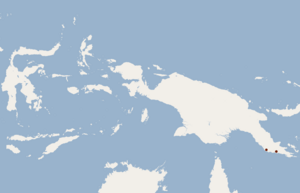New Guinea big-eared bat facts for kids
Quick facts for kids New Guinea big-eared bat |
|
|---|---|
| Conservation status | |
| Scientific classification | |
| Genus: |
Pharotis
|
| Species: |
imogene
|
 |
|
The New Guinea big-eared bat (also known as the Papuan big-eared bat) is a special type of vesper bat. Its scientific name is Pharotis imogene. This bat lives only in Papua New Guinea. It is a critically endangered species, which means it is in great danger of disappearing forever. This is mainly because its natural home is being lost.
This bat is the only known member of its group, called Pharotis. It is closely related to another group of bats known as Nyctophilus.
For a long time, people thought this bat had become extinct after 1890. But in 2014, scientists made an exciting discovery! They realized that a female bat found near Kamali in 2012 was actually a New Guinea big-eared bat. This meant the species was still alive!
Contents
What is the New Guinea Big-Eared Bat?
The group Pharotis and the species Pharotis imogene were first described in 1914. This was done by a British zoologist named Oldfield Thomas.
The first bats used to describe the species were collected in 1890 by Lamberto Loria. Thomas received these bats from Giacomo Doria of the Museo Civico di Storia Naturale.
This bat belongs to the family Vespertilionidae, which are common evening bats. It is related to the similar Nyctophilus bats. Both are part of a larger group called Nyctophilini, known as the big-eared bats of Australia and New Guinea.
How to Identify This Bat
The New Guinea big-eared bat has dark brown fur. Its ears and wing membranes are also brown. It looks a lot like the small-toothed long-eared bat, Nyctophilus microdon. Because they look so similar, people sometimes confuse them.
You can tell the New Guinea big-eared bat apart by looking at the skin between its nostrils. In this bat, this skin has no hair. In Nyctophilus bats, this skin has fine hairs.
Here are some measurements for this bat:
- Its forearm is about 39.6 millimeters (1.56 inches) long.
- Its ears are long, about 24 millimeters (0.94 inches).
- Its tragi (small flaps inside the ear) are also long, about 15 millimeters (0.59 inches).
- Its head and body together measure about 50.1 millimeters (1.97 inches).
- These bats weigh around 7.7 grams (0.27 ounces).
Bat Behavior and Diet
Scientists do not know much about the New Guinea big-eared bat. This is because it is very rare and hard to find.
However, because it has such large ears, scientists think it might hunt insects using echolocation. Echolocation is like using sound waves to "see" in the dark. The bat sends out sounds and listens for the echoes to find prey.
It is also thought that this bat might catch its prey by gleaning. This means it might pick insects off surfaces like leaves or tree trunks, instead of catching them while flying.
Where the Bat Lives
The bat found in 2012 was in a lowland rainforest that had been logged. This area was in the Abau District of Papua New Guinea.
We do not know exactly what kind of home this bat prefers. But it might live in lowland sclerophyll woodlands. These are forests with tough, dry leaves. It might also live in woodlands that have patches of rainforest.
Protecting the New Guinea Big-Eared Bat
In 2020, the IUCN (International Union for Conservation of Nature) officially listed this species as critically endangered. This means it faces a very high risk of becoming extinct in the wild.
As mentioned before, this bat was not seen for sure between 1890 and 2012. In 2012, researchers rediscovered the species when they caught an adult female. At first, they were not sure what species it was.
Because it is in such great danger, the Alliance for Zero Extinction has identified it as a species that could soon disappear forever. In 2013, Bat Conservation International also put this bat on its list of 35 top priority species for conservation around the world.


